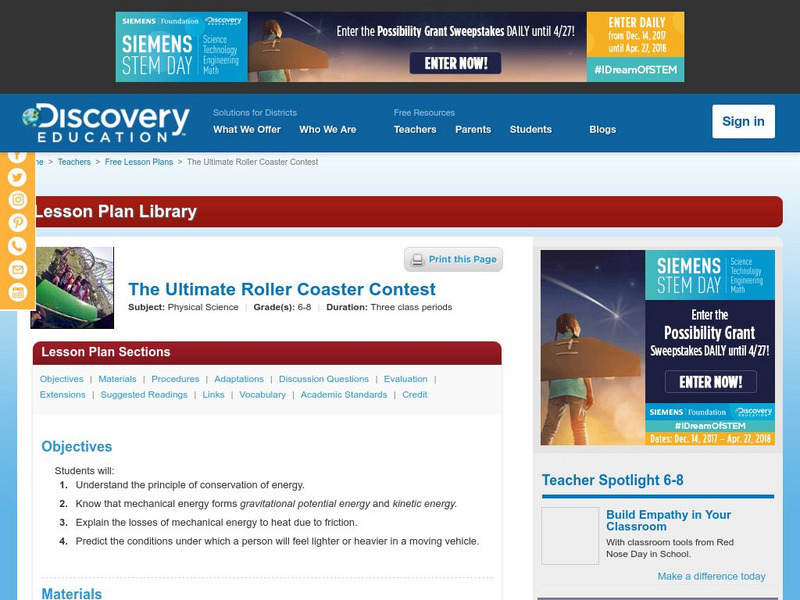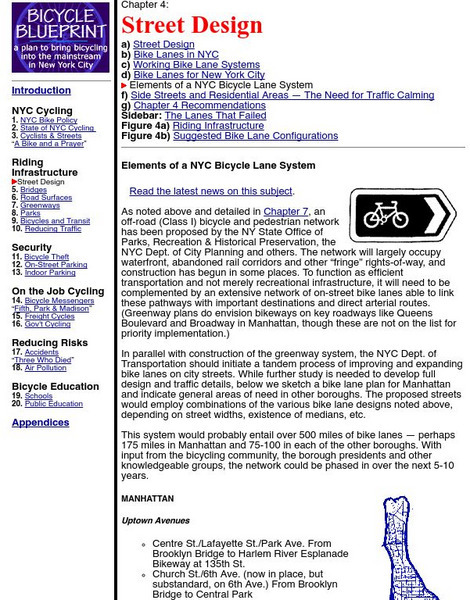Other
Alliance to Save Energy: Conservation for the Ages
"In this project based lesson plan, students learn about various types of energy and the need to conserve energy, write a children's story about saving energy, and read their energy books to elementary students."
University of Colorado
University of Colorado: Ph Et Interactive Simulations: Energy Skate Park: Basics
An interactive skate park simulation that teaches about conservation of energy, kinetic energy, potential energy, thermal energy, and friction. This simulation can either be downloaded or played online and includes handouts, lesson...
Science Buddies
Science Buddies: Paper Roller Coasters: Kinetic and Potential Energy
In this lesson, your students will learn about kinetic and potential energy as they build their own roller coasters from simple classroom materials.
PBS
Pbs News Hour Extra: Choosing an Automobile, Understanding Alternative Fuels
This lesson plan encourages learners to look at alternative methods of fuel and explore the various impacts each has on the environment.
Canada Science and Technology Museum
Canada Science and Technology Museum: Background Information for Energy
Energy! What do you know about it? Use this terrific site to find out everything about it through a series of Q&As. Educators will find useful lesson plans at the related Teacher's site.
Science Buddies
Science Buddies: Balloon Car
Students will design, build, and race balloon-powered cars in this fun lesson that teaches about engineering design and kinetic and potential energy.
National First Ladies' Library
National First Ladies' Library: First Lady Biography: Michelle Obama
A thorough biography of Michelle Obama. Discover where Michelle Robinson was born, her family, her education, career, and life as wife to the President of the United States. Standards based lesson plans featuring passions of the First...
Discovery Education
Discovery Education: The Ultimate Roller Coaster Contest
Middle schoolers design and build a three hill "tennis ball" roller coaster made of cardboard. During the design and building process, students explore the concepts of potential and kinetic energy and how they change as the roller...
Other
Climate Reality Project
To help combat the climate crisis America faces and to protect our environment, the Climate Reality Project clean energy plan includes efficiency, generation, transmission, and transportation.
Museum of Science
The Atom's Family: Radiometer
Help Dracula find out about light waves by using a virtual radiometer.
University of Colorado
University of Colorado: Ph Et Interactive Simulations: Pendulum Lab
An interactive simulation that teaches about periodic motion, simple harmonic motion, and conservation of energy. Observe one or two pendulums to determine how the swing is influenced by the length of the string, the mass of the pendulum...
University of Colorado
University of Colorado: Ph Et Interactive Simulations: Masses & Springs
An interactive simulation that teaches about springs, Hooke's Law, and conservation of energy observing changes in kinetic, potential, and thermal energy by adjusting the stiffness and damping of springs holding various masses. This...
Alabama Learning Exchange
Alex: Actions at Plate Boundaries
This lesson will allow the students to understand the cause and effects of plates interactions. The students will learn that plate boundaries function as a release for much of the Earth's potential energy. The students will be able to...
PBS
Nova: Car of the Future
In this activity, student teams research and develop a proposal to decrease the carbon footprint of their city's/town's public transportation system and then prepare a report that explains why their transportation plan is the best for...
Other
Nyc Transportation Alternatives: Bicycle Blueprint
This site details "a plan to bring bicycling into the mainstream in New York City." Offers maps and detailed information on improving big city other-than-auto transportation choices.
University of Texas at Austin
The University of Texas Mc Donald Observatory: Spectroscope
This lesson guides learners to build a spectroscope, use it as a tool, and interpret their observations by applying concepts of conservation of energy and properties of matter.











